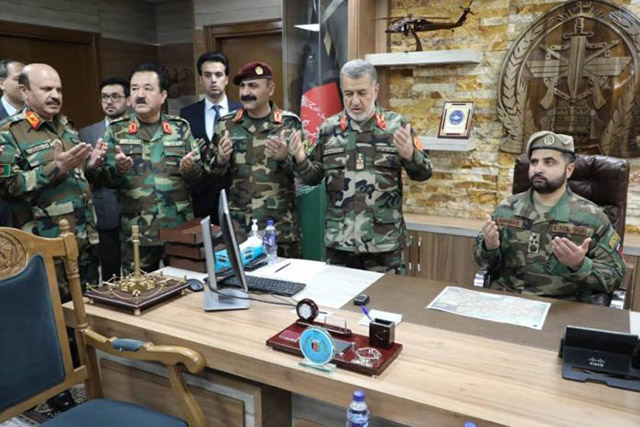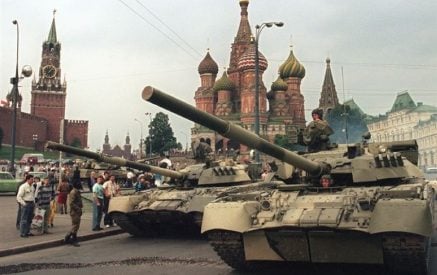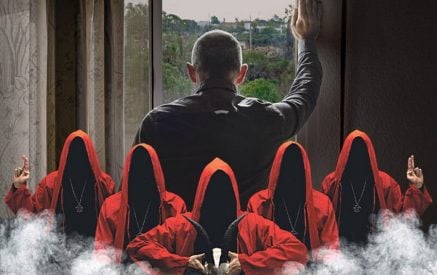The Armenian Mirror-Spectator
by Raffi Elliott
As I watched footage of Taliban fighters entering the vacant presidential palace in Kabul from my living room in Yerevan on Sunday, August 17, swiping through my smartphone, I came across a post on the r/armenia subreddit entitled: “What can we learn from the Taliban?” I rolled my eyes as I tossed my phone onto the couch, sighing at the prospects of yet another feeble attempt to weave associations between Armenia and a far-off current affairs issue where there was none.
Read also
But that was three days ago now. In the meantime, that question somehow managed to cling to my thoughts. In the space of eight months, I witnessed, in real time, the fall of two important cities which held such significance to me both as an Armenian and a Canadian.
I was still learning to walk and talk when Shushi was liberated in 1992. While I have since visited Shushi dozens of times since then — the last time being mere days before its capture — the other city, I have never set foot in. If Kabul has changed hands four times in my lifetime, the start of my adulthood, like many others of my generation, really started on October 2001, when the Afghan capital was liberated as part of NATO’s Operation Enduring Freedom. The Foreverwar that followed over the next two decades has become such a ubiquitous presence on the political, cultural and professional definition of my generation that its sudden end feels…uncomfortable.
Yet I couldn’t help wondering whether the sacrifice of 150 fellow Canucks, and 3,350 other Coalition servicemen and women was worth it as the Taliban rolled into Kabul, seemingly reversing 20 years of effort. In much the same way, we soured at the thought of the thousands of Armenian lives forfeited, tens of millions of dollars and three decades of collective Armenian effort undone as the stormtroopers of the Caspian Dictatorship unfurled their flag in Shushi’s newly-renovated town hall a mere eight months prior.
But upon revisiting the question, I like to think that perhaps the lessons of Afghanistan should reverberate among Armenians in subtle, yet non-negligible ways. Despite the circumstances, historical underpinnings, and geopolitical stakes being widely different, the outcome of “America’s longest war” in Afghanistan does provide round-about answers to questions that Armenians have been reeling over since last autumn’s war.
I’ve identified four such lessons.
Resting on Our Laurels
In a July 28 piece for Foreign Policy magazine which now reads as laughably aged, columnist Anchal Vohra insisted that fears of an imminent collapse of the Afghan State were overblown. Hailing the capabilities of the western-trained and equipped Afghan National Army, the veteran journalist argued that the line of battle was “far more balanced than most outside observers seem to believe.” She also pointed to the remobilization of militias by famed warlords Abdul Rashid Dostum, Karim Khalili and Ahmad Massoud (Son of the legendary Mujaheed Ahmad Shah Massoud) — known for having defeated both the Soviets in 1989 and the Taliban in 2001 — as evidence of mounting resistance against their onslaught.
Within days of the piece going to print, Kabul had fallen yet again, Khalili reappeared in Taliban captivity and Dostum had fled into Uzbekistan. Only the young Massoud appears to be fighting on, rallying those willing to fight the Taliban to his stronghold in the Panjshir Valley.
The fact that such legendary commanders who had literally brought down empires would be routed so completely in a mere two decades is as shocking as it is telling. While there are many complex tribal and strategic matters that are particular to Afghanistan, it’s hard not to draw parallels between these Afghan warlords and the brilliant Armenian generals of yester-war — the very same generals who would live to see their legacies undone within a mere 26 years.
Just like their Afghan counterparts, the victors of Armenia’s 1988-94 David-and-Goliath struggle against the Azerbaijanis helped themselves to the spoils. They appointed each other to high-ranking government posts, built opulent mansions overlooking Yerevan and Stepanakert, and accumulated vast amounts of wealth, power, influence, and girth, while the military and state apparatus they helped create suffered from chronic neglect. The Azeris would never fight back, they insisted, as the history of Armenia’s 1994 victory was mythologized to the point where it had become a foregone conclusion in our collective memory. But much like the Taliban, the Azerbaijanis bid their time, regrouped, and tried again as Armenia’s superpower protector stood idly by. Generals and politicians attempted to replicate the strategies of 1994 across the battlefields of 2020 with predictable (in hindsight) results.
Last year, Armenia learned the hard way that it could not afford to rest as its enemies brooded.
Skin in the Game
If news of Dostum’s flight proved a demoralizing blow to the floundering Afghan Army, President Ashraf Ghani’s escape proved the final nail in the coffin. It should come as no surprise that the corrupt kleptocrats who diverted millions of international aid money over their decades of rule over post-Taliban Afghanistan had an exit strategy. While such a complete structural collapse did not happen in Armenia, rumors were ripe of high-ranking officers leaving their posts, and certain generals having fueled private jets ready on the tarmac at Zvartnots to take their families to Russia or whichever Schengen country they had quietly received dual citizenship from or opened bank accounts in.
It’s no secret that Armenian officers and government officials have accrued large investments in property, business interests, and other assets abroad over the years. Some might question the commitment of such people to a cause as important as the physical defense of their nation when such escape routes remain an option to them. But officers and politicians should not be the only ones expected to have skin in the game. It is not uncommon for Armenians to apply for, and receive second citizenships as a “security guarantee” while repats occasionally hesitate to apply for Armenian citizenship to avoid conscription.
But the future of Armenia should not be a half-assed effort. We’re either committed to moving Armenia’s status from survive to thrive, or we’re not. To achieve these goals, Armenia needs our funds, yes, but it also needs our trust, and above all, us.
Technology Doesn’t Win Wars
When the Turkish-built and piloted Bayraktar drones first appeared in the skies over Artsakh last September, they did more than spread havoc on the battlefield. They also shattered a long-held conceit among the Armenian public that brave, patriotic men armed with the duty to defend their homes would outmatch any foe. Such misplaced trust in the martial abilities of our warrior-culture blinded us to the danger posed by a decades-worth of an increasingly sophisticated military build-up across the Line-of-Contact.
Yet if the war revealed one thing, it’s that the bravery of underequipped, and poorly commanded militias is insufficient to deflect drone strikes, or sustain military operations in a 5th generation battlespace where the enemy enjoys the advantage of integrated command and information logistics.
But a lightning offensive by fighters in sandals packed on Toyota pickup trucks armed with AKs against an enemy trained, equipped, and coordinated by the most effective military powers on the planet does make me wonder if the conclusion that technology wins wars may be premature.
Out of context, the success of the Taliban strategy may be puzzling military analysts and observers alike. But in battlefields scattered across the Middle East, examples of small, ill-equipped militias giving the most sophisticated militaries in the region a run for their money are not hard to come by. Israeli strategists still struggle to explain their blunders against Hezbollah in 2006. Seven years into the Yemeni Civil War, a coalition of wealthy Gulf States has yet to subdue the scrappy Houthi insurgency. Despite boasting NATO’s second largest military, Turkey has scored few gains in its four decades-long struggle against the PKK.
Clearly, technological advantage alone does not determine the course of wars. While personal bravery, sacrifice, elan, and patriotism do play a role, they are no substitute for strategy, discipline, diplomacy, and logistics.
Closer scrutiny of the Afghan National Army’s performance (or lack-there-of) provides an answer to another “what-if” scenario oft-presented by Armenian armchair generals since the war. Those speculating as to whether the course of last autumn’s war would have been altered had the Armenian military establishment invested in a particular anti-aircraft system, picked drones over traditional aircraft or any one of the Wunderwaffen often suggested on the internet are missing the point.
Weapons are tools, and tools are only as good as their users and the tasks they’re suited for. Much of the sophisticated machinery that the ANA inherited from Coalition Forces lay idle in warehouses for the Taliban to seize because the ANA lacked personnel who could read or write, let alone trained to survive or operate these systems. So could a full battery of Pantsir-SM medium-range surface-to-air missile systems, as some claim, theoretically defeat Bayraktars? Probably. If we ignore the exorbitant operational cost involved, the probability of success depends heavily on crew training and the development of appropriate defensive doctrines suited to their capabilities.
Thus taking sophisticated weapons into a warzone does not, a victory make. This isn’t to downplay the urgent necessity for the Armenian armed forces to modernize their capabilities in a cost-effective manner.
Graveyard of Empires
“Afghanistan is the Graveyard of Empires,” President Joe Biden said of US troop withdrawal as he addressed the nation on Monday. This old aphorism, long (mis)used in reference to the failure of a succession of foreign powers to control the patch of mountains at the heart of Central Asia.
Yet, it wouldn’t be much of a stretch to apply that same adage to Armenia as well. For a nation whose wars have all been fought and lost (As Saroyan put it), it has managed to endure. While the Neo-Assyrian, Roman, Byzantine, Ottoman, and Soviet Empires now exist only in the annals of History, Armenia definitely remains a living, breathing sovereign state in the modern world. If this past serves as any indication for the future, it shall outlive current enemies as well.
If there is one way in which the people of Armenia may see eye-to-eye with the Taliban is that the resilience of Mountain people, combined with resolve around a shared goal and patience proves impossible to overcome.
As the saying goes: They tried to bury us, they didn’t know we were seeds.


























































